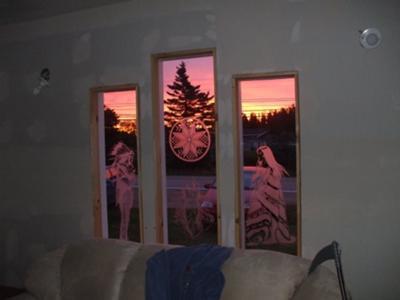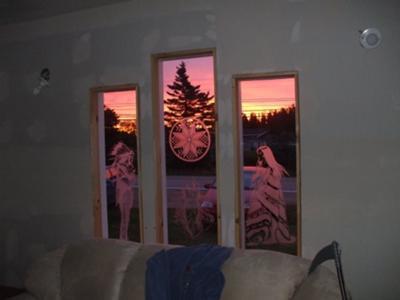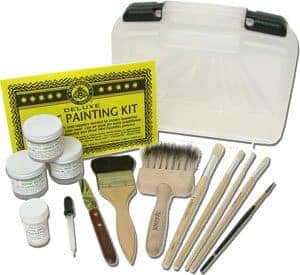How do I Stop Glass Paint Going Streaky
I want to paint part of a glass panel on my front door – it measures 37 x 7cm. I have bought paint which is in a bottle and the liquid is very thin (so i presume that i will have to do a couple of coats to achieve the end result). There is no instructions it only says “Decor Glass”. I have practised on glass cups and each time there are streaks, how do i prevent this?Lesley
Milly’s reply: I’m not sure if you are trying to use the glass paint vertically? If so, it’s nearly impossible not to get streaks.
Is there any way of taking the glass out?
If you aren’t doing the painting vertically, then you have to put a fair bit on and gently push it where you want it to go, rather than using gestural brush strokes.
It’s not easy to achieve a lovely streak-free result, but I hope this helps..
Painting Sandblasted Plexiglass

Native American Sandblast Design
A few years ago I had some plexiglass sandblasted to create beautiful native American etchings. I used these as my front windows. They are being replaced, and since the sun will no longer be able to shed light on them, I thought perhaps I could paint them with something (don’t know what) so that the image could still be seen. However, I intend to try to use them as a room divider,so they would actually have to be pretty opaque where ever the glass isn’t etched. Nicole
Any suggestions?
Milly’s reply:
These look great! What a lovely idea. I’m not sure that the cold paints that you can buy will make this any better than it is – they might even kill the design off, if you know what I mean.
Would it be possible to make a feature of the screen with careful use of lighting? If it’s anything like glass it will catch the light on the edges and be shown off to best advantage.
Sorry I can’t be of more help, and hope you find a solution. They’re too good not to be seen.
Why Paint Silver Stain on Reverse Side?
1) Although I have read your item on silver stain I am still not clear why it is is usually fired on the ‘back’ of the glass. If the glass is already painted then surely it wouldn’t matter that the silver stain couldn’t penetrate the paint because the painter wouldn’t want the silver stain on the part of the glass beneath the paint?
2) When the stain has been fired is there a residue of silver nitrate left on the surface of the glass that can be removed, and if so, how?Noah Albert
Milly’s reply: Hi Noah, I agree, it does seem silly to paint the ‘back’ with stain, but there are good reasons.
Both your questions link up really, as the unpleasant residue or bloom that you mention when firing is something you don’t want on the ‘front’ of your work.
Silver stain is applied on the back of the glass for a number of reasons. It fires into the glass, rather than remaining on the surface (like paint) so it needs to be applied on clear glass for this to happen.
The residue. This doesn’t always happen, but when it does, it’s best that this is on the outside of the window, and not visible from inside. You’ll see this ‘bloom’ on church windows if you look from the outside – little non-reflective patches. These can be removed carefully with diluted hydrofluoric acid. This is another reason for doing it on the back – the acid would remove the paintwork otherwise.
Having said all this, technically you’re right – you can apply silver stain over paint, or around the painted areas. Just be careful not to over-fire it, as it may produce the unsightly metallic bloom on your precious work. Good luck.
Silver Stain Kiln Firing Schedule
I’m using a Reusche silver stain and am unsure about the firing schedule to get it up to the proper temperature. Bring it up fast or slow? How long to soak? I’ve read up on the precautions and differences with silver stain, but am unsure on firing.Steve Hynds
Milly’s reply: Hi Steve, thanks for your question. Yes, silver stain – a bit tempermental! You’re using the best make though, so you should be able to get some lovely results. Don’t forget to test it first on a piece of glass that hasn’t got loads of painting on it – as it’s the lowest and last thing to be fired, it can ruin all your work if you’re not careful and do your tests. There’s more information on my Stain Glass page if it helps.
OK – the firing schedule for silver stain I use is:
100C per hour to 550C. Soak for 5mins.
10C ph to 530. Soak for 5mins.
Off.
If you’re in a rush, you can take the glass up 300C an hour – I was always told to do it slowly so have never tried a quicker firing for silver stain. I always do as I’m told! Hope that’s ok, post a photo of your finished work when it’s done.
This painting starter kit is available on Amazon Peter Mcgrain Deluxe Paint Starter Kit (paid link)



Hi, can a professional glass painting artist paint a double glazed window successfully if it is removed from its frame.
I would like a painting of a blue peacock on a branch.
I’m not good enough to attempt it so I’m hoping someone who reads this is!!
You’d have to have the sealed unit removed and replaced with a triple glazed unit with the painted sheet in the middle. Spacers hold it in place. I hope that helps.